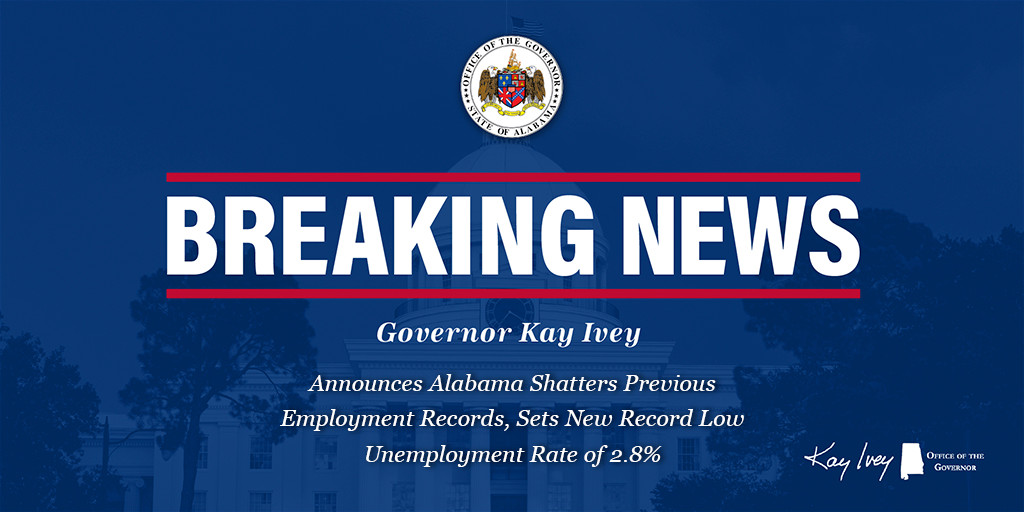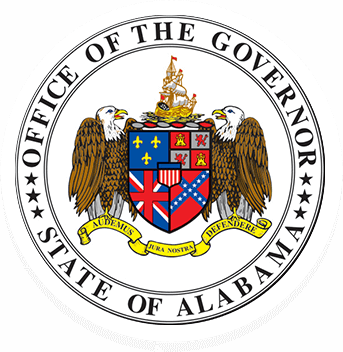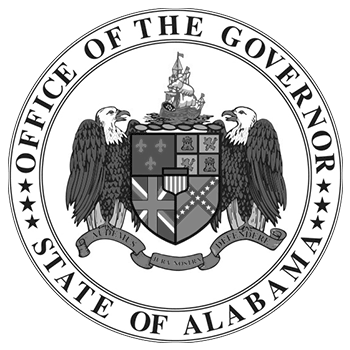Governor Ivey Announces Alabama Shatters Previous Employment Records, Sets New Record Low Unemployment Rate of 2.8%

MONTGOMERY – Governor Kay Ivey on Friday announced that Alabama’s preliminary, seasonally adjusted April unemployment rate is 2.8%, down from March’s rate of 2.9%, and well below April 2021’s rate of 3.6%. April’s rate represents a new record low unemployment rate for Alabama.
“I am thrilled that after 202 years of trying, Alabama has once again reached a new record low unemployment rate, and this forward momentum is only continuing. The people of Alabama want to work, plain and simple, and that combined with our efforts helped us reach the lowest unemployment rate in our state’s history, yet again,” said Governor Ivey. “We have more people working today than at any other point in our state’s history. We are shattering record after record, and we’re just getting started!”
April’s rate represents 63,208 unemployed persons, a new record low, compared to 65,441 in March and 81,599 in April 2021. Additionally, 2,213,189 people were counted as employed, also a new record high, up from 2,204,911 in March, and up 43,594 from April 2021. The civilian labor force increased by 25,203 over-the-year to 2,276,397.
“Alabama is leading the nation, no doubt about it,” added Governor Ivey. “We will continue working hard to ensure our people are working. Folks, the best is yet to come.”
Total private weekly wages increased in April to $990.46, a new record high, and an increase of $21.12 from April 2021. The leisure and hospitality sector’s weekly wages also set a new record high, increasing from $382.92 in April 2021 to $411.31 this month, representing a yearly increase of $28.39. Earlier this week, Governor Ivey had a stop in Conecuh County touting the strong numbers achieved by the state’s tourism industry.
Wage and salary employment increased in April by 6,000. Monthly gains were seen in the leisure and hospitality sector (+3,200), the manufacturing sector (+2,000), and the government sector (+1,500), among others. Over the year, wage and salary employment increased by 42,800, with gains in the trade, transportation, and utilities sector (+11,100), the leisure and hospitality sector (+10,400), and the manufacturing sector (+6,300), among others.
“I can’t tell you the last time I’ve seen a jobs report with this many positives,” said Alabama Department of Labor Secretary Fitzgerald Washington. “This is great news for Alabama’s economy and especially for our coastal region as we move into the prime tourist season. On top of the other records, we’ve also increased wages to a new record high, with average weekly wages gaining over $21 dollars over-the-year. Additionally, the leisure and hospitality sector set yet another record for weekly wages, with a yearly increase of more than $28.”
Counties with the lowest unemployment rates are: Shelby County at 1.4%, Marshall County at 1.5%, and Morgan, Madison, Limestone, Elmore, Cullman, and Blount Counties at 1.6%. Counties with the highest unemployment rates are: Wilcox County at 7.7%, Lowndes County at 5.5%, and Perry County at 5.4%.
Major cities with the lowest unemployment rates are: Homewood at 1.1%, Trussville at 1.2%, and Alabaster and Vestavia Hills at 1.3%. Major cities with the highest unemployment rates are: Selma at 6.9%, Prichard at 4.5%, and Anniston at 4.0%.
###
Members of the media seeking more information should contact Communications Director Tara Hutchison.
An Equal Opportunity Employer / Program
Auxiliary aids and services available upon request to individuals with disabilities.
Dial 711 for TTY Accessibility
“Seasonal adjustment” refers to BLS’s practice of anticipating certain trends in the labor force, such as hiring during the holidays or the surge in the labor force when students graduate in the spring, and removing their effects to the civilian labor force.
The Current Population (CPS), or the household survey, is conducted by the Census Bureau and identifies members of the work force and measures how many people are working or looking for work.
The establishment survey, which is conducted by the Bureau of Labor Statistics (BLS), a division of the U.S. Department of Labor, surveys employers to measure how many jobs are in the economy. This is also referred to as wage and salary employment.
Provided by the Office of the Governor of Alabama | governor.alabama.gov

